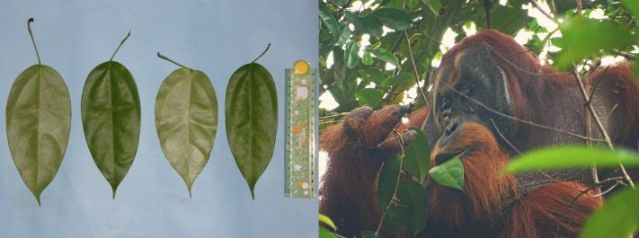Animal Behavior
Orangutan Treats His Wound with a Medicinal Plant
Researchers observed an orangutan applying chewed-up leaves to a facial wound.
Posted May 2, 2024 Reviewed by Lybi Ma
Key points
- The leaves were from Akar Kuning, a plant with several medicinal properties.
- This may be a form of self-medication to reduce pain and inflammation and support wound healing.
- This self-medicating behavior may have evolved in a common ancestor shared by humans and great apes.

The wild Sumatran orangutans of the Suaq Balimbing research area in Gunung Leuser National Park, Indonesia, have been the subjects of ongoing observational studies since 1994. But these great apes are still full of surprises.
In a new paper, researchers describe how a male orangutan chewed the leaves of a plant used in traditional medicine and applied them to a wound on his cheek. It’s the first report of suspected wound treatment by a wild animal using a plant with known medicinal properties.
Botanical Therapy
A male Sumatran orangutan known as Rakus was observed by the researchers with a fresh wound on his cheek in June 2022. Three days later, they witnessed an intriguing chain of events. Rakus chewed the leaves of a plant (Fibraurea tinctoria, also called Akar Kuning) and then applied the resulting juices directly onto his facial wound. He repeated this behavior for seven minutes and then, as a last step, fully covered the wound with the chewed leaves. He then continued feeding on the plant for 30 minutes.
Over the following days, there were no signs of infection. The wound closed within five days and was healed, with only a faint scar remaining after one month.
“What I think is interesting is that this behavior seems to be intentional and goal-oriented,” says study lead author Isabelle Laumer, a cognitive biologist at the Max Planck Institute of Animal Behavior in Germany. “He precisely applied the plant matter to his wound several times over a prolonged period. He selectively treated his wound and not any other body parts.”

Rakus also chose a plant full of healing chemical compounds. Akar Kuning is used in traditional Southeast Asian medicine to treat diseases including dysentery, diabetes, and malaria. Previous studies have shown that it contains furano diterpenoids and protoberberine alkaloids, known to have antibacterial, anti-inflammatory, anti-fungal, antioxidant, and other biological activities. Rakus’s homemade poultice of chewed-up leaves may have helped reduce injury-related pain and inflammation and supported wound healing.
Wild Medicine
Self-medication has been documented in multiple wild primate species. Primates have been observed swallowing and chewing plants with medicinal properties as well as rubbing them onto their fur—but not applying them to recent wounds.
There is only one other study of purported active wound treatment by great apes. A few years ago, researchers reported that one population of chimpanzees in the Loango National Park, Gabon, applied flying insects to their own wounds and those of others. However, the researchers could not identify the insects or make any conclusions about the efficacy of the treatment.
“Our observation of Rakus applying this plant is possibly the first record of active wound management with a biologically active substance by a wild animal,” says Laumer.

Laumer and colleagues do not know how or where this behavior originated. It is possible that Rakus stumbled upon it through accidental individual innovation—perhaps he inadvertently touched a wound while feeding on Akar Kuning and experienced its potent analgesic effects, causing him to repeat the behavior. It is also possible that Rakus previously learned the behavior from other orangutans in the region where he was born, outside of Suaq Balimbing. Rakus, like all adult male orangutans, dispersed from his birth area after puberty. Since young orangutans rely on social learning to acquire the skills necessary for adult life, Rakus may have observed his mother or another orangutan demonstrating how to treat wounds with Akar Kuning.
The researchers also note that they have never observed other orangutans at Suaq Balimbing using Akar Kuning to treat their wounds. However, this could partly be because physical fights between orangutans are rare in the area. Suaq Balimbing is characterized by high food availability, high levels of social tolerance between orangutans, and relatively stable social hierarchies, all of which mean the researchers rarely encounter injured individuals.
All in the Family
Rakus’s goal-oriented behavior and the medicinal properties of his chosen treatment suggest that preparing and applying healing ointments may be a form of self-medication that reduces pain and inflammation and accelerates wound healing.

The findings may provide insights into the evolution of this behavior among humans and their closest relatives, the great apes. The earliest mention of treating human wounds dates to roughly 2200 BC. Cultures including Sumerians, Greeks, Mayans, and Egyptians used various materials to clean and make plasters and bandages for wounds, such as oils, herbs, vinegar, and honey.
“It seems that forms of active wound treatment are present not just in humans, but also possibly in the African apes—the chimpanzees that treat wounds with flies—and in Asian great apes, the Sumatran orangutans,” says Laumer. “Therefore, there may be a common underlying mechanism for recognizing and applying substances with medicinal properties. It is possible that our last common ancestor already showed similar forms of this wound treatment behavior.”
References
Laumer IB, Rahman A, Rahmaeti T, Azhari U, Hermansyah, Atmoko SSU, and Schuppli C. 2024. Active self-treatment of a facial wound with a biologically active plant by a male Sumatran orangutan. Nature Scientific Reports. Doi: 10.1038/s41598-024-58988-7.


